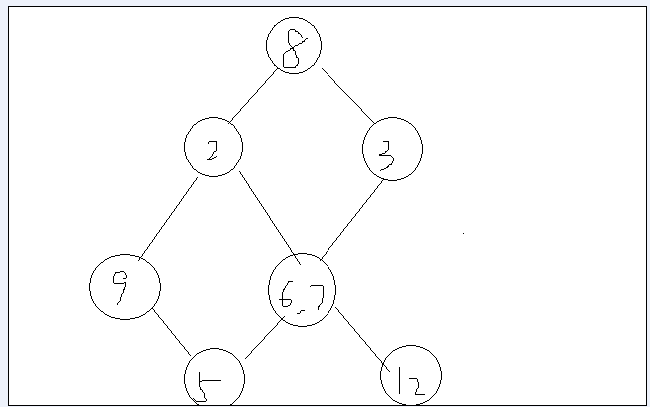uva 699 - The Falling Leaves
| The Falling Leaves |
Each year, fall in the North Central region is accompanied by the brilliant colors of the leaves on the trees, followed quickly by the falling leaves accumulating under the trees. If the same thing happened to binary trees, how large would the piles of leaves become?
We assume each node in a binary tree "drops" a number of leaves equal to the integer value stored in that node. We also assume that these leaves drop vertically to the ground (thankfully, there's no wind to blow them around). Finally, we assume that the nodes are positioned horizontally in such a manner that the left and right children of a node are exactly one unit to the left and one unit to the right, respectively, of their parent. Consider the following tree:
The nodes containing 5 and 6 have the same horizontal position (with different vertical positions, of course). The node containing 7 is one unit to the left of those containing 5 and 6, and the node containing 3 is one unit to their right. When the "leaves" drop from these nodes, three piles are created: the leftmost one contains 7 leaves (from the leftmost node), the next contains 11 (from the nodes containing 5 and 6), and the rightmost pile contains 3. (While it is true that only leaf nodes in a tree would logically have leaves, we ignore that in this problem.)
Input
The input contains multiple test cases, each describing a single tree. A tree is specified by giving the value in the root node, followed by the description of the left subtree, and then the description of the right subtree. If a subtree is empty, the value -1 is supplied. Thus the tree shown above is specified as 5 7 -1 6 -1 -1 3 -1 -1. Each actual tree node contains a positive, non-zero value. The last test case is followed by a single -1 (which would otherwise represent an empty tree).Output
For each test case, display the case number (they are numbered sequentially, starting with 1) on a line by itself. On the next line display the number of "leaves" in each pile, from left to right, with a single space separating each value. This display must start in column 1, and will not exceed the width of an 80-character line. Follow the output for each case by a blank line. This format is illustrated in the examples below.Sample Input
5 7 -1 6 -1 -1 3 -1 -1 8 2 9 -1 -1 6 5 -1 -1 12 -1 -1 3 7 -1 -1 -1 -1
Sample Output
Case 1: 7 11 3 Case 2: 9 7 21 15
思维定势真可怕,一直纠结于建完二叉树然后考虑怎么计算落叶的数量;其实不用那么麻烦参考了http://hi.baidu.com/goomaple/item/8efc5151fa99438dacc857b6
每个节点在垂直方向落叶,我们水平建立一条数轴,只需考虑一维的坐标,假设当前节点坐标为x,则他左儿子为x-1,右儿子为x+1,如此就符合题目所要求的树叶下落的方向;题目直接给了先序遍历,所以不用建树直接递归的读入数据读入-1为递归终止条件,
#include <stdio.h>
int a[81],left,right;
void sort(int num,int pos)
{int x,y;
if (num!=-1)
{if (pos<left) left=pos;
if (pos>right) right=pos;
a[pos]+=num;
scanf("%d",&x);
sort(x,pos-1);
scanf("%d",&y);
sort(y,pos+1);
}
};
int main()
{int i,n,sum=0;
while (scanf("%d",&n)&&n!=-1)
{for (i=0;i<81;i++) a[i]=0;
++sum;
left=40; right=40;
sort(n,40);
printf("Case %d:\n",sum);
for (i=left;i<right;i++)
printf("%d ",a[i]);
printf("%d\n\n",a[right]);
}
return 0;
}
